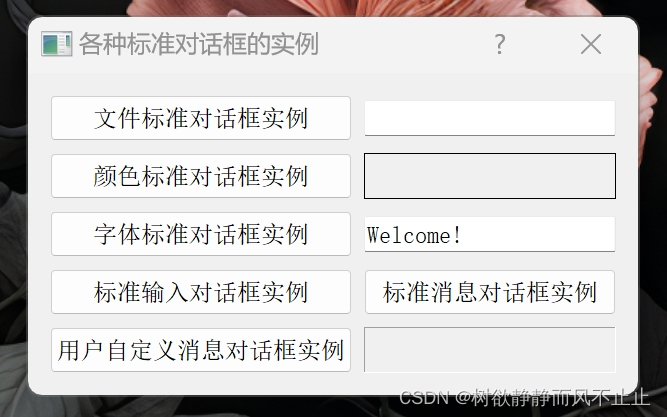
目录
一、设计需求
二、实现代码
三、代码解析
四、总结
一、设计需求
Qt提供了很多标准的对话框。例如标准文件对话框(QFileDialog)、标准颜色对话框(QColorDialog)、标准字体对话框 (QFontDialog)、标准输入对话框 (QInputDialog) 及消息对话框 (QMessageBox)。本文展示各种对话框的简单使用方法以及自定义消息框。
二、实现代码
main文件:
#include "dialog.h"
#include <QApplication>int main(int argc, char *argv[])
{QApplication a(argc, argv);Dialog w;w.show();return a.exec();
}
dialog文件:
#ifndef DIALOG_H
#define DIALOG_H#include <QDialog>
#include <QLineEdit>
#include <QGridLayout>
#include "inputdlg.h"
#include "msgboxdlg.h"
class Dialog : public QDialog
{Q_OBJECTpublic:Dialog(QWidget *parent = 0);~Dialog();
private:QPushButton *fileBtn;QLineEdit *fileLineEdit;QGridLayout *mainLayout;QPushButton *colorBtn;QFrame *colorFrame;QPushButton *fontBtn;QLineEdit *fontLineEdit;QPushButton *inputBtn;InputDlg *inputDlg;QPushButton *MsgBtn;MsgBoxDlg *msgDlg;QPushButton *CustomBtn;QLabel *label;
private slots:void showFile();void showColor();void showFont();void showInputDlg();void showMsgDlg();void showCustomDlg();
};#endif // DIALOG_H
#include "dialog.h"
#include<QGridLayout>
#include<QFileDialog>
#include<QPushButton>
#include <QColorDialog>
#include <QFontDialog>
#include <QMessageBox>
Dialog::Dialog(QWidget *parent): QDialog(parent)
{//设置标题setWindowTitle(tr("各种标准对话框的实例"));//标准文件对话框fileBtn=new QPushButton; //各个控件对象的初始化fileBtn->setText(tr("文件标准对话框实例"));fileLineEdit=new QLineEdit; //用来显示选择的文件名mainLayout=new QGridLayout(this); //布局设计mainLayout->addWidget(fileBtn,0,0);mainLayout->addWidget(fileLineEdit,0,1);connect(fileBtn,SIGNAL(clicked()),this,SLOT(showFile())); //事件关联//标准颜色对话框colorBtn=new QPushButton; //创建各个控件的对象colorBtn->setText(tr("颜色标准对话框实例"));colorFrame=new QFrame;colorFrame->setFrameShape(QFrame::Box);colorFrame->setAutoFillBackground(true);mainLayout->addWidget(colorBtn,1,0); //布局设计mainLayout->addWidget(colorFrame,1,1);connect(colorBtn,SIGNAL(clicked()),this,SLOT(showColor())); //事件关联//标准字体对话框fontBtn=new QPushButton; //创建控件的对象fontBtn->setText(tr("字体标准对话框实例"));fontLineEdit=new QLineEdit; //显示更改的字符串fontLineEdit->setText(tr("Welcome!"));mainLayout->addWidget(fontBtn,2,0); //布局设计mainLayout->addWidget(fontLineEdit,2,1);connect(fontBtn,SIGNAL(clicked()),this,SLOT(showFont())); //事件关联//标准输入对话框inputBtn =new QPushButton; //创建控件的对象inputBtn->setText(tr("标准输入对话框实例"));mainLayout->addWidget(inputBtn,3,0); //布局设计connect(inputBtn,SIGNAL(clicked()),this,SLOT(showInputDlg()));//事件关联//消息对话框MsgBtn =new QPushButton; //创建控件对象MsgBtn->setText(tr("标准消息对话框实例"));mainLayout->addWidget(MsgBtn,3,1);connect(MsgBtn,SIGNAL(clicked()),this,SLOT(showMsgDlg()));//自定义消息框CustomBtn =new QPushButton;CustomBtn->setText(tr("用户自定义消息对话框实例"));label =new QLabel;label->setFrameStyle(QFrame::Panel|QFrame::Sunken);mainLayout->addWidget(CustomBtn,4,0);mainLayout->addWidget(label,4,1);connect(CustomBtn,SIGNAL(clicked()),this,SLOT(showCustomDlg()));
}Dialog::~Dialog()
{}
/*
QString QFileDialog::getOpenFileName
(QWidget* parent=0, //标准文件对话框的父窗口const QString & caption=QString ( ), //标准文件对话框的标题名const QString & dir=QString( ), //指定了默认的目录,若此参数带有文件名,则文件将是默认选中的文件const QString & filter=QString(), //此参数对文件类型进行过滤,只有与过滤器匹配的文件类型才显示,可以同时指定多种过滤方式供用户选择,多种过滤器之间用“::”隔开QString * selectedFilter=O, //用户选择的过滤器通过此参数返回Options options=0 //选择显示文件名的格式,默认是同时显示目录与文件名
)
如果选择取消(Cancel),则返回一个空串儿
*/
void Dialog::showFile()
{//获取用户选择的文件名QString s = QFileDialog::getOpenFileName(this,"open file dialog","/","*");fileLineEdit->setText(s);
}
/*
QColor getColor
(const QColor& initial=Qt::white,QWidget* parent=0 //标准颜色对话框的父窗口
);
指定了默认选中的颜色,默认为白色。通过 QCok)r::isValid()函数可以判断用户选择的
颜色是否有效,但是当用户在选择文件时,如果选择“取消”(Cancel), 则 QColor::is函
数将返回 false
*/
void Dialog::showColor()
{//获取用户选择的颜色QColor c = QColorDialog::getColor(Qt::blue);if(c.isValid()){//设置颜色colorFrame->setPalette(QPalette(c));}
}
/*
QFont getFont
(bool* ok,QWidget* parent=0 //标准字体对话框的父窗口
);
注:若用户选择 则该参数*ok 将设为true, 函数返回用户所选择的字体;否则,将
设为false, 此时函数返回默认字体。
*/
void Dialog::showFont()
{bool ok;QFont f = QFontDialog::getFont(&ok);if (ok){//设置字体fontLineEdit->setFont(f);}
}void Dialog::showInputDlg()
{//新建InputDlg对象inputDlg =new InputDlg(this);inputDlg->show();
}void Dialog::showMsgDlg()
{//新建MsgBoxDlg对象msgDlg =new MsgBoxDlg();msgDlg->show();
}void Dialog::showCustomDlg()
{label->setText(tr("Custom Message Box"));QMessageBox customMsgBox;customMsgBox.setWindowTitle(tr("用户自定义消息框")); //设置消息框的标题QPushButton *yesBtn=customMsgBox.addButton(tr("Yes"),QMessageBox::ActionRole);QPushButton *noBtn=customMsgBox.addButton(tr("No"),QMessageBox::ActionRole);QPushButton *cancelBtn=customMsgBox.addButton(QMessageBox::Cancel);customMsgBox.setText(tr("这是一个用户自定义消息框!"));customMsgBox.setIconPixmap(QPixmap("Qt.jpeg"));customMsgBox.exec();if(customMsgBox.clickedButton()==yesBtn)label->setText("Custom Message Box/Yes");if(customMsgBox.clickedButton()==noBtn)label->setText("Custom Message Box/No");if(customMsgBox.clickedButton()==cancelBtn)label->setText("Custom Message Box/Cancel");return;
}
InputDlg文件:
//添加的头文件
#include <QLabel>
#include <QPushButton>
#include <QGridLayout>
#include <QDialog>
class InputDlg : public QDialog
{Q_OBJECTpublic:InputDlg(QWidget* parent=0);
private slots:void ChangeName();void ChangeSex();void ChangeAge();void ChangeScore();
private:QLabel *nameLabel1;QLabel *sexLabel1;QLabel *ageLabel1;QLabel *scoreLabel1;QLabel *nameLabel2;QLabel *sexLabel2;QLabel *ageLabel2;QLabel *scoreLabel2;QPushButton *nameBtn;QPushButton *sexBtn;QPushButton *ageBtn;QPushButton *scoreBtn;QGridLayout *mainLayout;
};
#include "inputdlg.h"
#include <QInputDialog>
InputDlg::InputDlg(QWidget *parent) :QDialog(parent)
{setWindowTitle(tr("标准输入对话框的实例"));nameLabel1 =new QLabel;nameLabel1->setText(tr("姓名:"));nameLabel2 =new QLabel;nameLabel2->setText(tr("张三")); //姓名的初始值nameLabel2->setFrameStyle(QFrame::Panel|QFrame::Sunken);nameBtn =new QPushButton;nameBtn->setText(tr("修改姓名"));sexLabel1 =new QLabel;sexLabel1->setText(tr("性别:"));sexLabel2 =new QLabel;sexLabel2->setText(tr("男")); //性别的初始值sexLabel2->setFrameStyle(QFrame::Panel|QFrame::Sunken);sexBtn =new QPushButton;sexBtn->setText(tr("修改性别"));ageLabel1 =new QLabel;ageLabel1->setText(tr("年龄:"));ageLabel2 =new QLabel;ageLabel2->setText(tr("21")); //年龄的初始值ageLabel2->setFrameStyle(QFrame::Panel|QFrame::Sunken);ageBtn =new QPushButton;ageBtn->setText(tr("修改年龄"));scoreLabel1 =new QLabel;scoreLabel1->setText(tr("成绩:"));scoreLabel2 =new QLabel;scoreLabel2->setText(tr("80")); //成绩的初始值scoreLabel2->setFrameStyle(QFrame::Panel|QFrame::Sunken);scoreBtn =new QPushButton;scoreBtn->setText(tr("修改成绩"));//新建布局mainLayout =new QGridLayout(this);mainLayout->addWidget(nameLabel1,0,0);mainLayout->addWidget(nameLabel2,0,1);mainLayout->addWidget(nameBtn,0,2);mainLayout->addWidget(sexLabel1,1,0);mainLayout->addWidget(sexLabel2,1,1);mainLayout->addWidget(sexBtn,1,2);mainLayout->addWidget(ageLabel1,2,0);mainLayout->addWidget(ageLabel2,2,1);mainLayout->addWidget(ageBtn,2,2);mainLayout->addWidget(scoreLabel1,3,0);mainLayout->addWidget(scoreLabel2,3,1);mainLayout->addWidget(scoreBtn,3,2);mainLayout->setMargin(15);mainLayout->setSpacing(10);//连接信号和槽函数connect(nameBtn,SIGNAL(clicked()),this,SLOT(ChangeName()));connect(sexBtn,SIGNAL(clicked()),this,SLOT(ChangeSex()));connect(ageBtn,SIGNAL(clicked()),this,SLOT(ChangeAge()));connect(scoreBtn,SIGNAL(clicked()),this,SLOT(ChangeScore()));
}
/*
QString getText
(QWidget* parentz, //标准输入对话框的父窗口const QString title, //标准输入对话框的标题名const QString label, //标准输入对话框的标签提示QLineEdit::EchoMode mode=QLineEdit::Normal, //指定标准输入对话框中 QLineEdit 控件的输入模式const QString& text=QString( ), //标准字符串输入对话框弹出时QLineEdit 控件中默认出现的文字bool* ok=0, //指示标准输入对话框的哪个按钮被触发,若为 true, 则表示用户单击了 “OK” (确定)按钮;若为 false, 则表示用户单击了 “Cancle” (取消) 按钮Qt::WindowFlags flags=0 //指明标准输入对话框的窗体标识
);
*/
void InputDlg::ChangeName()
{bool ok;QString text=QInputDialog::getText(this,tr("标准字符串输入对话框"),tr("请输入姓名:"), QLineEdit::Normal,nameLabel2->text(),&ok);if (ok && !text.isEmpty())nameLabel2->setText(text);
}
/*
QString getltem
(QWidget* parent, //标准输入对话框的父窗口const QString& title,//标准输入对话框的标题名const QString& label,//标准输入对话框的标签提示const QStringList& items,//指定标准输入对话框中QComboBox控件显示的可选条目为一个QStringList对象int current=0,//标准条目选择对话框弹出时QComboBox控件中默认显示的条目序号bool editable=true, //指定 QComboBox 控件中显示的文字是否可编辑bool* ok=0,//指示标准输入对话框的哪个按钮被触发,若ok为true, 则表示用户单击了“OK”(确定)按钮;若ok为false, 则表示用户单击了“Cancle"(取消)按钮Qt::WindowFlags flags=0//指明标准输入对话框的窗口标识
);
*/void InputDlg::ChangeSex()
{QStringList SexItems;SexItems << tr("男") << tr("女");bool ok;QString SexItem = QInputDialog::getItem(this, tr("标准条目选择对话框"),tr("请选择性别:"), SexItems, 0, false, &ok);if (ok && !SexItem.isEmpty())sexLabel2->setText(SexItem);
}
/*
int getInt
(QWidget* parent, //标准输入对话框的父窗口const QString& title, //标准输入对话框的标题名const QString& label, //标准输入对话框的标签提示int value=0, //指定标准输入对话框中QSpinBox控件的默认显示值int min=-2147483647, //指定 QSpinBox 控件的数值范围int max=2147483647,int step=1, //指定 QSpinBox 控件的步进值bool* ok=0, //用于指示标准输入对话框的哪个按钮被触发。若ok为true, 则表示用户单击了“0K”(确定) 按钮;若ok为false, 则表示用户单击了 “Cancel" (取消) 按钮Qt::WindowFlags flags=0 //指明标准输入对话框的窗口标识
);
*/
void InputDlg::ChangeAge()
{bool ok;int age = QInputDialog::getInt(this, tr("标准int类型输入对话框"),tr("请输入年龄:"), ageLabel2->text().toInt(&ok), 0, 100, 1, &ok);if (ok)ageLabel2->setText(QString(tr("%1")).arg(age));
}
/*
double getDouble
(QWidget* parent,//标准输入对话框的父窗口const QString& title,//标准输入对话框的标题名const QString& label,//标准输入对话框的标签提示double value=0,//指定标准输入对话框中 QSpinBox 控件默认的显示值double min=-2147483647,//指定 QSpinBox 控件的数值范围double max=2147483647,int decimals=1,//指定 QSpinBox 控件的步进值bool* ok=0,//用于指示标准输入对话框的哪个按钮被触发,若ok为true, 则表示用户单击了“OK”(确定)按钮;若ok为false, 则表示用户单击了“Cancel"(取消)按钮Qt::WindowFlags flags=0//指明标准输入对话框的窗口标识
);
*/
void InputDlg::ChangeScore()
{bool ok;double score = QInputDialog::getDouble(this, tr("标准double类型输入对话框"),tr("请输入成绩:"),scoreLabel2->text().toDouble(&ok), 0, 100, 1, &ok);if(ok)scoreLabel2->setText(QString(tr("%1")).arg(score));
}
MsgBoxDlg文件:
//添加的头文件
#include <QLabel>
#include <QPushButton>
#include <QGridLayout>
#include <QDialog>
class MsgBoxDlg : public QDialog
{Q_OBJECT
public:MsgBoxDlg(QWidget* parent=0);
private slots:void showQuestionMsg();void showInformationMsg();void showWarningMsg();void showCriticalMsg();void showAboutMsg();void showAboutQtMsg();
private:QLabel *label;QPushButton *questionBtn;QPushButton *informationBtn;QPushButton *warningBtn;QPushButton *criticalBtn;QPushButton *aboutBtn;QPushButton *aboutQtBtn;QGridLayout *mainLayout;
};#include "msgboxdlg.h"
#include <QMessageBox>
MsgBoxDlg::MsgBoxDlg(QWidget *parent) :QDialog(parent)
{setWindowTitle(tr("标准消息对话框的实例")); //设置对话框的标题//新建控件对象label =new QLabel;label->setText(tr("请选择一种消息框"));questionBtn =new QPushButton;questionBtn->setText(tr("QuestionMsg"));informationBtn =new QPushButton;informationBtn->setText(tr("InformationMsg"));warningBtn =new QPushButton;warningBtn->setText(tr("WarningMsg"));criticalBtn =new QPushButton;criticalBtn->setText(tr("CriticalMsg"));aboutBtn =new QPushButton;aboutBtn->setText(tr("AboutMsg"));aboutQtBtn =new QPushButton;aboutQtBtn->setText(tr("AboutQtMsg"));//布局mainLayout =new QGridLayout(this);mainLayout->addWidget(label,0,0,1,2);mainLayout->addWidget(questionBtn,1,0);mainLayout->addWidget(informationBtn,1,1);mainLayout->addWidget(warningBtn,2,0);mainLayout->addWidget(criticalBtn,2,1);mainLayout->addWidget(aboutBtn,3,0);mainLayout->addWidget(aboutQtBtn,3,1);//事件关联connect(questionBtn,SIGNAL(clicked()),this,SLOT(showQuestionMsg()));connect(informationBtn,SIGNAL(clicked()),this,SLOT(showInformationMsg()));connect(warningBtn,SIGNAL(clicked()),this,SLOT(showWarningMsg()));connect(criticalBtn,SIGNAL(clicked()),this,SLOT(showCriticalMsg()));connect(aboutBtn,SIGNAL(clicked()),this,SLOT(showAboutMsg()));connect(aboutQtBtn,SIGNAL(clicked()),this,SLOT(showAboutQtMsg()));
}
/*
StandardButton QMessageBox::question
(QWidget* parent, //消息框的父窗口指针const QString& title, //消息框的标题栏const QString& text, //消息框的文字提示信息StandardButtons buttons=Ok, //填写希望在消息框中出现的按钮,可根据需要在标准按钮中选择,用|连写,默认为QMessageBox::Ok。StandardButton defaultButton=NoButton //默认按钮,即消息框出现时,焦点默认处于哪个按钮上
);
*/
void MsgBoxDlg::showQuestionMsg()
{label->setText(tr("Question Message Box"));switch(QMessageBox::question(this,tr("Question消息框"),tr("您现在已经修改完成,是否要结束程序?"),QMessageBox::Ok|QMessageBox::Cancel,QMessageBox::Ok)){case QMessageBox::Ok:label->setText("Question button/Ok");break;case QMessageBox::Cancel:label->setText("Question button/Cancel");break;default:break;}return;
}
/*
StandardButton QMessageBox::information
(QWidget*parent, //消息框的父窗口指针const QString& title, //消息框的标题栏const QString& text, //消息框的文字提示信息StandardButtons buttons = OK, //同 Question 消息框的注释内容StandardButton defaultButton=NoButton //同 Question 消息框的注释内容
);
*/
void MsgBoxDlg::showInformationMsg()
{label->setText(tr("Information Message Box"));QMessageBox::information(this,tr("Information消息框"),tr("这是Information消息框测试,欢迎您!"));return;
}
/*
StandardButton QMessageBox::warning
(QWidget* parent, //消息框的父窗口指针const QString& title, //消息框的标题栏const QString& text, //消息框的文字提示信息StandardButtons buttons=Ok, //同Question 消息框的注释内容StandardButton defaultButton=NoButton //同 Question 消息框的注释内容
);
*/
void MsgBoxDlg::showWarningMsg()
{label->setText(tr("Warning Message Box"));switch(QMessageBox::warning(this,tr("Warning消息框"),tr("您修改的内容还未保存,是否要保存对文档的修改?"),QMessageBox::Save|QMessageBox::Discard|QMessageBox::Cancel,QMessageBox::Save)){case QMessageBox::Save:label->setText(tr("Warning button/Save"));break;case QMessageBox::Discard:label->setText(tr("Warning button/Discard"));break;case QMessageBox::Cancel:label->setText(tr("Warning button/Cancel"));break;default:break;}return;
}
/*
StandardButton QMessageBox::critical
(QWidget* parent, //消息框的父窗口指针const QString& title, //消息框的标题栏const QString& text, //消息框的文字提示信息StandardButtons buttons=Ok, //同 Question 消息框的注释内容StandardButton defaultButton=NoButton //同 Question 消息框的注释内容
);
*/
void MsgBoxDlg::showCriticalMsg()
{label->setText(tr("Critical Message Box"));QMessageBox::critical(this,tr("Critical消息框"),tr("这是一个Critical消息框测试!"));return;
}
/*
void QMessageBox::about
(QWidget* parent, //消息框的父窗口指针const QString& title, //消息框的标题栏const QString& text //消息框的文字提示信息
);
*/
void MsgBoxDlg::showAboutMsg()
{label->setText(tr("About Message Box"));QMessageBox::about(this,tr("About消息框"),tr("这是一个About消息框测试!"));return;
}
/*
void QMessageBox::aboutQt
(QWidget* parent, //消息框的父窗口指针const QString& title=QString() //消息框的标题栏
);
*/
void MsgBoxDlg::showAboutQtMsg()
{label->setText(tr("About Qt Message Box"));QMessageBox::aboutQt(this,tr("About Qt消息框"));return;
}
效果展示:

三、代码解析
标准基本对话框所需的静态函数,如下表所示。
四、总结
使用合适的对话框,可以给用户带来很好的使用体验。当标准消息框都不能满足开发的需求时,可以自定义消息框。



✅)





的学习下载和配置)

)







